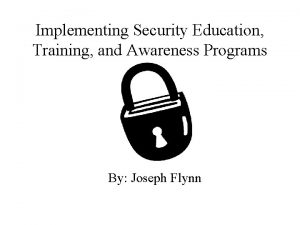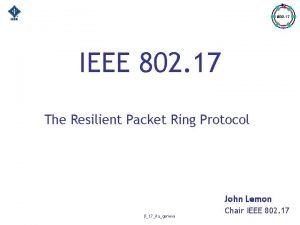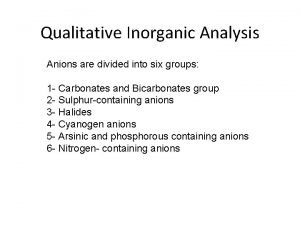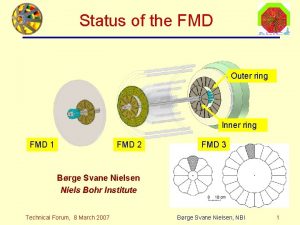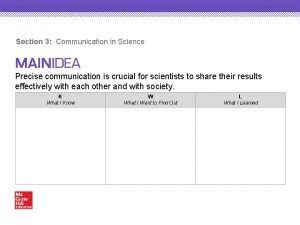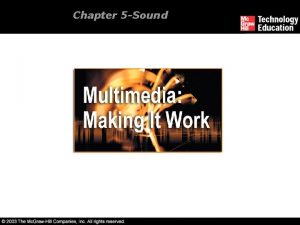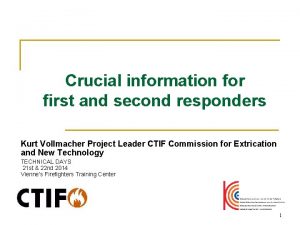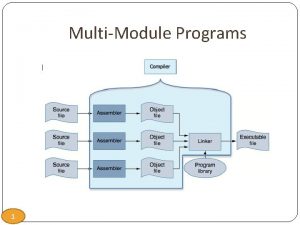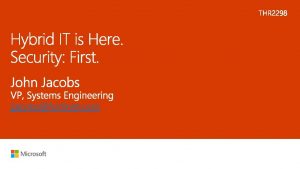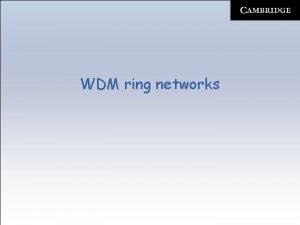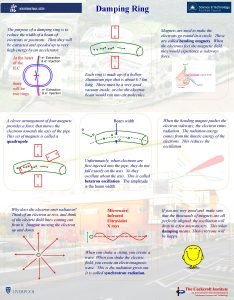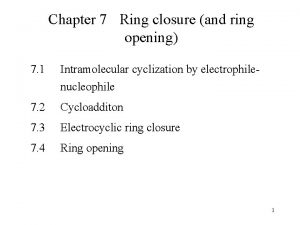Crucial Security Programs Ring 1 vs Ring 2





































- Slides: 37

Crucial Security Programs Ring -1 vs. Ring -2: Containerizing Malicious SMM Interrupt Handlers on AMD-V Pete Markowsky Senior Security Researcher pmarkows@harris. com

You might remember me from such films as. . . • Who Am I? – Pete Markowsky • Senior Security Researcher at Crucial Security Programs, Harris Corporation • transzorp on IRC and Twitter • Worked in –. edu –. com –. mil 21 -Nov-20

What is this talk about? • System Management Mode and System Management Mode Interrupts (SMIs) • Virtualization on the AMD platform • The interplay between virtualization extensions in AMD-V and System Management Mode (SMM) – which mode already has or can seize control of execution, when, and where 11/21/2020

Why should I care? • If you’re building a security mechanism based on a VMM on AMD-V • Normally SMM code runs outside of the VMM’s protections • Malicious System Mode Interrupt (SMI) handlers can be used for: – bypassing Intel’s TXT – rootkits – privilege escalation attacks 11/21/2020

Assumptions • An attacker has the ability to install an SMI handler – can take advantage of BIOS overwrites or cache attacks – they have root in a guest • An attacker may have subverted the BIOS (up to a point) 11/21/2020

The problem 11/21/2020

Ring -2: System Management Mode (SMM) • System Management Mode is – a 16 -bit x 86 operating mode like real-mode – transparent to the OS – supposed to be for power management • SMM is entered only when a System Mode Interrupt (SMI) is asserted by hardware • Called “Ring -2” because normally – there are no restrictions to the I/O ports or memory – it has the same privileges as in Ring 0 – it can manipulate all of system memory 11/21/2020

Ring -2: SMRAM • SMM code in SMRAM – range of physical memory • SMBASE MSR – defines start of SMRAM • Default size on AMD 64 64 K – can range from 32 K – 4 GB 11/21/2020

Ring -2: Where did it come from? • Installed by the BIOS – BIOS sets up SMRAM (copies handler) – Configures SMM MSRs – Typically locks SMM registers by setting the HWCR. SMMLOCK bit • Prevents access to SMRAM 11/21/2020

Ring -2: SMM security • Two segments of physical memory protected for SMM code – ASeg: 0 x. A 0000 – 0 x. BFFFF – TSeg: defined by SMM_ADDR and SMM_MASK • Bits in SMM_MASK MSR set protection for segments • Protected segments can only be accessed in SMM 11/21/2020

Ring -2: System Mode Interrupt (SMI) • Special Non-Maskable Interrupt • Takes priority over other interrupts • Two types – internal: generated by hardware in response to IOIO instructions • which IOIO depend on motherboard logic – external: generated by hardware • Causes switch to SMM 11/21/2020

Ring -2: In what modes can an SMI occur? 11/21/2020

Ring -2: What happens during an SMI • Stops fetching instructions • Processor waits for currently executing instructions and buffered memory writes to finish • CPU state is saved in the SMRAM save state region • RIP changed to the start of the SMI handler 11/21/2020

Ring -2: SMI handler • Basically real mode x 86 code – segments are extended up to 4 GB • RSM instruction returns to previous execution mode • Address translation somewhat difficult – read CR 3 from save state area and do translation by hand 11/21/2020

Ring -2: Known methods of installing an SMI handler • Install a modified BIOS – write code to DRAM and set up appropriate MSRs • Find a bug in the SMI handler and exploit it – Invisible Things Labs Q 35 remapping attack • x 86 cache manipulation – Duflot’s attack 11/21/2020

Goal • Put all of the SMM code into a virtual machine so that its execution can be constrained by the VMM 11/21/2020

Ring -1: AMD 64 organization • Memory controller moved into the CPU 11/21/2020

Ring -1: AMD-V quick overview • x 86 -64 virtualization extensions – based around the VMRUN instruction and VMEXITs • Hypervisor defines VMEXIT conditions in a page of memory called the Virtual Machine Control Block (VMCB) – these conditions are called interceptions • One VMCB per guest • A VMCB defines processor state at resumption of execution (after a VMRUN) • A VMCB contains the state of the guest at the point of VMEXIT 11/21/2020

Ring -1: AMD-V quick overview 11/21/2020

Ring -1: Key features of AMD-V • Global Interrupt Flag (GIF) – when set to 1 allows all interrupts – when set to 0 blocks all interrupts including SMI • Paged Real Mode – run real mode code with paging protections applied • SMM_CTL register – allows VMM code to map SMRAM 11/21/2020

Ring -1: VMCB • VMCB has two parts – state save area: contains guest CPU state – control area: defines intercept conditions • Intercepts we care about: – – SMI (bit 98) RSM (bit 115) interception of IOIO instructions (bit 123) MSR_PROT (bit 124) 11/21/2020

Ring -1: Dealing with SMIs • Three solutions offered in AMD 64 System Programmer’s Manual – do nothing • SMM runs outside of VMM protections – intercept all IOIO instructions that can cause an SMI • complicated • doesn’t stop replaced handler – containerize the SMI Handler • run the SMI handler inside a virtual machine 11/21/2020

Containerizing SMI handlers • Two solutions – SMM hypervisor • rewrite SMRAM to contain a VMM that places the original SMM handler in a virtual machine – write code in the VMM to emulate switching to and from SMM, then run SMRAM code in a VM 11/21/2020

Ring -1: Intercepting SMIs • The SMI intercept causes SMIs to transfer control to the VMM before the SMI handler • SMI intercept is ignored when the SMMLOCK is 1 11/21/2020

Ring -1: How to containerize an SMI handler • To containerize an SMI Handler: 1. 2. 3. 4. 5. 6. Ensure that HWCR. SMMLOCK is 0 Get access to SMRAM Configure a shadow page table for SMRAM Allocate and configure a VMCB for the SMM VM Configure guest VMCBs to intercept SMI Write code to copy guest state to and from the SMM VM’s save state area 11/21/2020

Ring -1: Ensuring that the SMMLOCK is 0 • Bit 0 of the HWCR is the SMMLOCK – if it’s 0 all SMM related MSRs may be written to in CPL 0 • SMM_KEY • Need some cooperation from BIOS Example: if (rdmsr(HWCR) & 1){ //locked use SMM_KEY wrmsr(SMM_KEY, passwd); if (rdmsr(HWCR)& 1) halt(); //WRONG PASS } 11/21/2020

Ring -1: Get access to SMRAM • Problem: SMRAM only accessible from SMM • Solution: SMM_CTL MSR • First map SMRAM region using SMM_CTL MSR – wrmsr(SMM_CTL, SMI_ENTER) – causes SMRAM to be mapped 11/21/2020

Ring -1: Allocate and configure a VMCB for the SMM VM • In the VMCB for the virtual machine you need to: – set VMCB CR 0 field to CR 0. PG=1 CR 0. PE=0 • Paged Real Mode – set VMCB CR 3 field to the physical address of the guest page table – set VMCB exception vector to intercept #PF – set VMCB RSM intercept – set VMCB shutdown intercept – intercept all SMM MSR writes 11/21/2020

Ring -1: Allocate and configure a guest VMCB • Prevent attempts to write MSRs by configuring VMCB MSRPM to: – intercept writes to • • • HWCR SMMBASE SMM_ADDR SMM_MASK SMM_CTL SMM_KEY 11/21/2020

Ring -1: Allocate a shadow page table • Paged real mode requires a shadow page table • Maps a guest linear address to a host physical address – (segment+offset) = guest linear address • Must create entries for SMRAM 11/21/2020

Ring -1: Copying to and from guest state • SMM save state area – 512 bytes at the end of SMRAM – contains processor state at the time of the SMI • Copy from SMM VM and guest VMCB • Filter out known values before returning to guest 11/21/2020

Demo • Modified MAVMM to containerize the handler 11/21/2020

What happened? 11/21/2020

Aside: SKINIT • SKINIT (Secure Kernel Init) – new instruction in AMD-V to securely load a VMM – similar to Intel’s SENTER • What it does – stops all other processors than the bootstrap processor – reinitializes processor state as if a reset has been asserted – uses DEV if set up in secure loader – sets GIF to 0 – loads an Secure Loader (SL) into RAM – verifies integrity of Secure Loader in TPM 11/21/2020

Differences from Intel VT • Conceptually AMD-V and Intel VT are similar • Intel VMCS is a variable length data structure • Intel does not have an explicit intercept for SMI – dual monitor treatment • put another hypervisor in SMRAM • not all VT hardware supports it. • Uses virtual 8086 mode to virtualize real mode code – sometimes needs other code to virtualize real mode code • vmxassist (from Xen) 11/21/2020

Thank You! • Thank you for attending my presentation and coming to Shmoo. Con 2010! 11/21/2020

Questions? • I’m happy to answer as many questions as I can in the time left 11/21/2020
 Provate security
Provate security Disadvantages of waterfall model in software engineering
Disadvantages of waterfall model in software engineering Security education training and awareness seta
Security education training and awareness seta Resilient packet ring
Resilient packet ring What is the brown ring in the brown ring test
What is the brown ring in the brown ring test Ring a ding ding dong christmas song
Ring a ding ding dong christmas song Strong no in c
Strong no in c Ring christmas bells ring them loud
Ring christmas bells ring them loud Content of hesselbach triangle
Content of hesselbach triangle Inner ring and outer ring
Inner ring and outer ring What is the inguinal region
What is the inguinal region Which resources played crucial roles in industrialization
Which resources played crucial roles in industrialization Performance management is crucial to ______.
Performance management is crucial to ______. Crucial conversations triangle
Crucial conversations triangle Contrasting statements crucial conversations
Contrasting statements crucial conversations Crucial conversations ppt
Crucial conversations ppt Crucial conversations 7 principles
Crucial conversations 7 principles Learn to look
Learn to look Start with heart
Start with heart Crucial systems
Crucial systems Crucial conversations chapter 7
Crucial conversations chapter 7 Crucial conversations chapter 6 summary
Crucial conversations chapter 6 summary Crucial conversations training ppt
Crucial conversations training ppt Section 3 communicating with graphs answer key
Section 3 communicating with graphs answer key Difficult conversations role play
Difficult conversations role play Crucial aspects of preparing digital audio files
Crucial aspects of preparing digital audio files What is constructive structure in asl
What is constructive structure in asl Crucial conversations
Crucial conversations Crucial conversation planner
Crucial conversation planner What processes are crucial to the ipde process
What processes are crucial to the ipde process Crucial conversations tips
Crucial conversations tips Kurt crucial
Kurt crucial The detective needs more time to inquire about the case
The detective needs more time to inquire about the case Characteristics of a conversation
Characteristics of a conversation Crucial conversations chapter 7
Crucial conversations chapter 7 Electronic mail security in network security
Electronic mail security in network security Security guide to network security fundamentals
Security guide to network security fundamentals Security guide to network security fundamentals
Security guide to network security fundamentals


